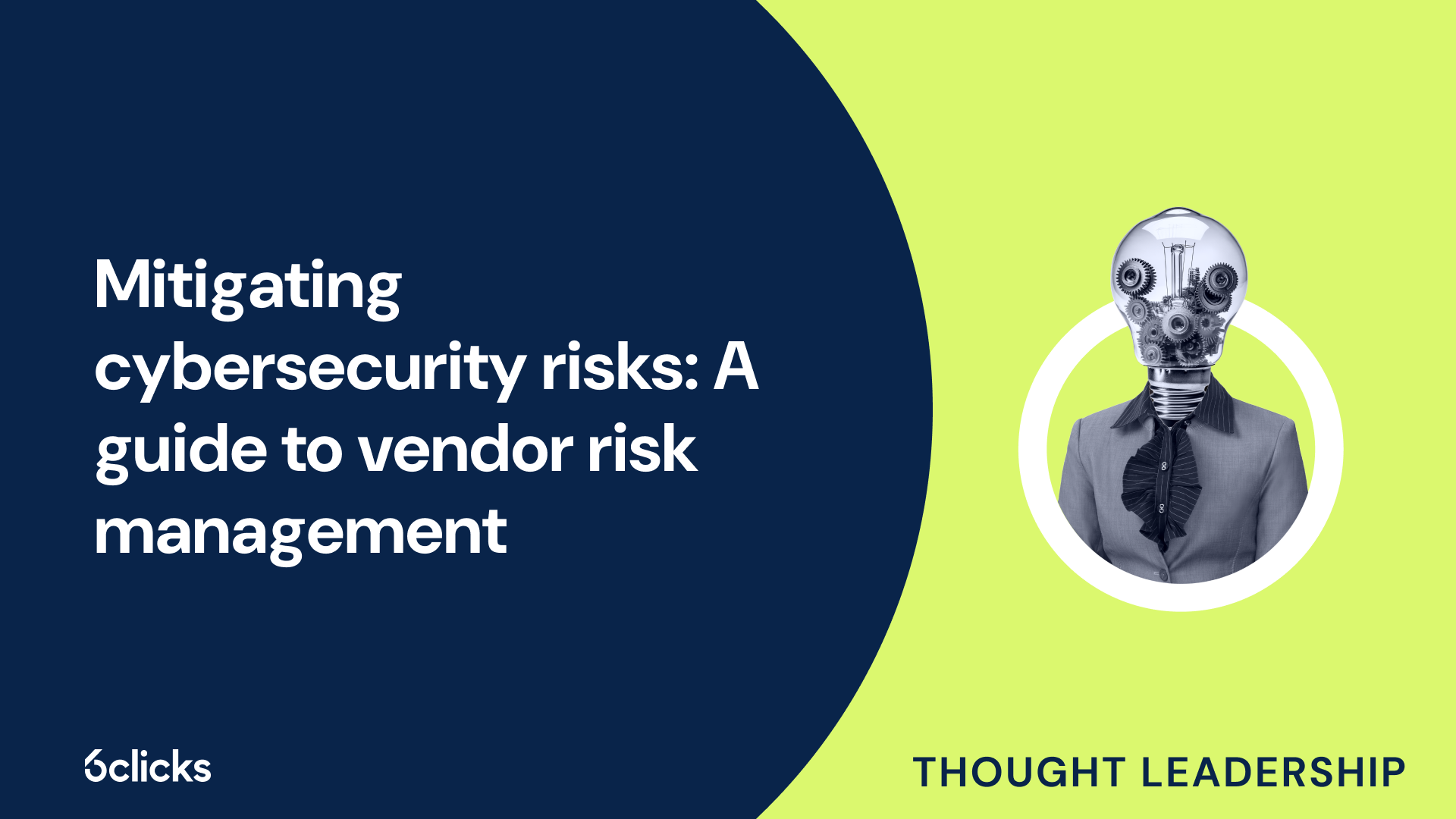The GRC buyer’s guide for 2025: Building resilience with AI-powered, federated solutions
-1.png?width=314&height=391&name=Group%20193%20(1)-1.png)
The GRC buyer’s guide for 2025: Building resilience with AI-powered, federated solutions
What is HITRUST?
HITRUST, which stands for Health Information Trust Alliance, is a cybersecurity framework that was developed to address the specific needs and challenges of the healthcare industry. It is based on the NIST Cybersecurity Framework, which is a widely recognized set of best practices and guidelines for managing and mitigating cybersecurity risks. HITRUST provides a comprehensive, standardized approach to ensure the security and privacy of patients' health information. It involves the implementation of a set of security controls that are tailored to the unique requirements of healthcare organizations, as well as a certification process to validate their compliance. This certification program helps healthcare organizations demonstrate their commitment to protecting sensitive patient data and meeting regulatory requirements. HITRUST also enables organizations in the healthcare sector to effectively manage their risk exposure and improve their security posture by providing a risk-based approach that takes into account their specific business needs and the ever-evolving threat landscape.
What is NIST?
The National Institute of Standards and Technology (NIST) is a federal agency that sets and promotes standards for a wide range of industries and sectors, including cybersecurity. The NIST cybersecurity framework is a set of guidelines and best practices designed to help organizations manage and mitigate cyber risks.
The purpose of the NIST cybersecurity framework is to provide a flexible and adaptable approach to cybersecurity that can be implemented by organizations of all types and sizes. It aims to help organizations identify and prioritize their cybersecurity risks, implement controls to manage these risks, and continuously monitor and improve their security posture.
The NIST cybersecurity framework is built on five key ideals. The first is the need to identify and categorize risks, understanding that different risks require different levels of protection. The second ideal is the need to establish a minimum baseline of controls to address the most common and foundational cybersecurity risks. The third ideal is the need to document controls and processes to ensure consistency and repeatability. The fourth ideal is the need to refine controls based on ongoing risk assessments and changes in the threat landscape. The final ideal is the need to regularly conduct annual security reviews and monitor security controls to ensure their effectiveness.
To maintain compliance with regulations such as the Health Insurance Portability and Accountability Act (HIPAA) and the Federal Information Security Management Act (FISMA), NIST recommends six organizational steps. These steps include categorizing information systems based on their risk levels, selecting and implementing the appropriate minimum baseline controls, documenting controls and processes, regularly refining controls based on risk assessments, conducting annual security reviews, and continuously monitoring security controls to ensure their effectiveness. By following these steps, healthcare organizations and other industries can enhance their security posture and protect sensitive information.
Is HITRUST based on NIST?
HITRUST, also known as the Health Information Trust Alliance, is a security framework and certification program specifically designed for the healthcare industry. While HITRUST incorporates elements from various industry standards and regulations, it is not directly based on the NIST cybersecurity framework.
Both HITRUST and the NIST cybersecurity framework have a common goal of enhancing cybersecurity practices, but they have different origins and approaches. The NIST cybersecurity framework was developed by the National Institute of Standards and Technology (NIST) in collaboration with industry experts and government agencies. It is a comprehensive framework that is applicable to organizations across all sectors.
On the other hand, HITRUST was developed by a consortium of healthcare organizations to address the unique security challenges faced by the healthcare sector. It incorporates requirements from multiple regulations and standards, including HIPAA, ISO, and NIST, among others. While HITRUST adopts certain aspects of the NIST framework, it also includes additional controls and requirements specific to the healthcare industry.
Both frameworks provide guidance and best practices for managing cybersecurity risks, but they serve different purposes. NIST focuses on providing a flexible and adaptable framework that can be implemented by organizations of all types, while HITRUST primarily targets healthcare organizations and their compliance with regulatory requirements.
History of HITRUST and NIST
HITRUST, which stands for Health Information Trust Alliance, was established in 2007. It was founded by a consortium of healthcare organizations and technology companies with the aim of addressing the unique security challenges faced by the healthcare sector. The consortium recognized the need for a comprehensive and standardized approach to cybersecurity in healthcare, given the increasing amount of sensitive patient data being stored and transmitted electronically. HITRUST developed the Common Security Framework (CSF) as a set of best practices and requirements specifically tailored to the healthcare industry. Over the years, HITRUST has continued to evolve and expand its certification program, partnering with various regulatory bodies and organizations to ensure the framework remains up to date and aligned with industry standards.
History of NIST:
The National Institute of Standards and Technology (NIST) has a long history of promoting and advancing technological innovation and standardization in the United States. Its involvement in cybersecurity began in the 1970s, when it started working on developing cryptographic algorithms and standards. Recognizing the growing need for a comprehensive cybersecurity framework, NIST collaborated with industry experts and government agencies to develop the NIST Cybersecurity Framework. This framework was first released in 2014 and has since become widely adopted by organizations across various sectors. NIST continues to play a crucial role in cybersecurity research, development, and standardization, working closely with stakeholders to address emerging threats and challenges in the digital age.
Origins of the HITRUST CSF
The HITRUST CSF, also known as the Health Information Trust Alliance Common Security Framework, was developed in response to the growing need for comprehensive cybersecurity in the healthcare industry. In 2007, a consortium of healthcare organizations and technology companies founded HITRUST to address the unique security challenges faced by healthcare organizations. They recognized the increasing amount of electronic patient data being stored and transmitted and the need for a standardized approach to cybersecurity.
The purpose of the HITRUST CSF is to simplify organizations' compliance efforts by integrating the requirements of multiple regulations into a single set of cybersecurity best practices. This streamlined approach allows healthcare organizations to efficiently implement and manage their security programs, ensuring compliance with regulatory requirements. By adopting the HITRUST CSF, organizations can achieve a higher level of security posture and reduce their risk exposure.
One of the benefits of the HITRUST CSF is its scalability. The framework can be customized to fit the needs of different industries and organization types, making it applicable not only to healthcare organizations but also to other sectors such as financial services and critical infrastructure industries. This flexibility allows organizations to tailor their cybersecurity programs based on their risk profile and level of maturity.
Origins of the NIST cybersecurity framework
The NIST Cybersecurity Framework is a set of guidelines and best practices developed by the National Institute of Standards and Technology (NIST) to help organizations manage and reduce their cybersecurity risks. The framework's primary goals are to provide a common language for organizations to assess and communicate their cybersecurity posture and to facilitate the development of effective cybersecurity programs.
The NIST Cybersecurity Framework is based on a risk-based approach, which means that organizations must first categorize their information systems and associated assets according to their risk level. This risk categorization process helps organizations identify and prioritize the cybersecurity controls and safeguards they need to implement.
Once the risk categorization is complete, organizations can establish a baseline of cybersecurity controls that should be implemented to achieve a minimum level of security. These baseline controls serve as a foundation for organizations to build upon and enhance their cybersecurity posture.
Documentation is a critical aspect of the NIST Cybersecurity Framework. Organizations are required to document their cybersecurity policies, procedures, and processes to ensure that they are well-defined, understood, and consistent. This documentation helps organizations track and communicate their progress towards achieving their cybersecurity goals.
The framework also emphasizes the importance of conducting regular risk assessments to identify and assess potential vulnerabilities, threats, and impacts to the organization's information systems. These risk assessments help organizations understand their risk profile and make informed decisions about the cybersecurity controls and safeguards they need to implement.
In addition to risk assessments, organizations are encouraged to conduct annual security reviews to evaluate the effectiveness of their cybersecurity programs. These reviews help organizations identify areas for improvement and make necessary adjustments to their cybersecurity controls.
Continuous monitoring is another key component of the NIST Cybersecurity Framework. Organizations are advised to establish processes to continuously monitor their information systems for cybersecurity threats and vulnerabilities. This allows organizations to promptly detect and respond to any potential security incidents.
How are HITRUST and NIST similar?
HITRUST and NIST share several similarities in their approach to cybersecurity. Both frameworks prioritize a risk-based approach, where organizations assess their information systems and assets to determine their risk level. This risk assessment process enables organizations to identify and prioritize the necessary cybersecurity controls and safeguards. Additionally, both frameworks emphasize the importance of documentation, requiring organizations to establish and maintain clear cybersecurity policies, procedures, and processes. Regular risk assessments and security reviews are also essential components of both frameworks, enabling organizations to understand their risk profile and make informed decisions about cybersecurity measures. Continuous monitoring is another shared aspect, as both HITRUST and NIST emphasize the need for organizations to establish processes to monitor their information systems for threats and vulnerabilities in real-time. By implementing these practices, organizations can enhance their cybersecurity posture and better protect their assets.
Risk-based approach to security controls
The risk-based approach to security controls involves the proactive management and minimization of risk within an organization. This approach involves several key elements to ensure the highest level of security for an organization's information assets.
Firstly, the risk-based approach necessitates the identification and correction of weaknesses in an organization's security posture. By regularly assessing and evaluating the effectiveness of security controls, organizations can identify vulnerabilities and take prompt action to address them.
Secondly, integrating information security into budget planning is essential for a risk-based approach. By considering the potential risks and associated costs, organizations can allocate resources to adequately protect their information assets.
Understanding and managing security vulnerabilities is another critical aspect of the risk-based approach to security controls. This includes staying up to date with emerging threats and vulnerabilities, as well as implementing appropriate controls to mitigate those risks.
Finally, the risk-based approach requires organizations to adapt their controls to emerging threats. By continuously monitoring and reassessing the risk landscape, organizations can adjust their security controls to reflect the changing threat environment and ensure the highest level of protection.
Harmonization with regulatory requirements
Harmonization with regulatory requirements is a crucial aspect of the HITRUST CSF (Common Security Framework) certification program, ensuring that organizations in the healthcare industry meet compliance standards. The HITRUST CSF incorporates various regulations and standards, such as HIPAA, NIST, ISO, and COBIT, among others, to provide a comprehensive framework for managing information security and privacy risks.
The HITRUST CSF certification program enables healthcare organizations to demonstrate compliance with regulatory requirements by aligning their security controls with industry best practices. By undergoing the HITRUST CSF assessment process, organizations can identify gaps in their security posture and implement necessary controls to address them.
In the latest version of the HITRUST CSF (9.4), there are notable updates that further enhance the harmonization with regulatory requirements. This includes the incorporation of the Cybersecurity Maturity Model Certification (CMMC) and updates to NIST 800-171 r2. The CMMC, developed by the Department of Defense (DoD), is aimed at standardizing cybersecurity practices across the defense supply chain. By including CMMC requirements, the HITRUST CSF ensures that healthcare organizations comply with security guidelines applicable to critical infrastructure industries.
Furthermore, the HITRUST CSF Version 9.4 aligns with the updates made to NIST 800-171 r2, which focus on protecting Controlled Unclassified Information (CUI) in non-federal systems and organizations. By incorporating these updates, the HITRUST CSF enables healthcare organizations to meet the evolving regulatory requirements and safeguard sensitive information.
Identification of maturity levels for security posture
HITRUST CSF and NIST both have frameworks that identify maturity levels for security posture to help organizations assess and improve their cybersecurity capabilities.
HITRUST CSF utilizes a risk-based approach to categorize organizations based on their level of security maturity. The framework classifies organizations into four levels: Basic, Standard, Intermediate, and Advanced. These levels represent different stages of security control implementation and maturity. Organizations at the Basic level have minimal security controls in place, while those at the Advanced level have comprehensive security programs implemented.
NIST, on the other hand, uses a five-tier maturity model to assess security posture. The model ranges from Tier 1 (Partial) to Tier 5 (Optimized). Each tier represents a different level of security controls and practices. In the lower tiers, organizations have ad hoc and reactive security measures, while in the higher tiers, organizations have proactive and continuously improving security programs.
These maturity levels help organizations evaluate their current security posture and understand areas that need improvement. By assessing their maturity level, organizations can prioritize their efforts to enhance their security controls and practices. The frameworks provide guidance on specific security control requirements for each maturity level, allowing organizations to systematically progress towards higher levels of security maturity.
Differences between HITRUST and NIST
HITRUST and NIST are two widely recognized frameworks that provide guidelines and standards for organizations in assessing and improving their cybersecurity posture. While both frameworks aim to enhance security controls, they differ in their approach and categorization of security maturity levels. HITRUST utilizes a four-level approach, ranging from Basic to Advanced, to classify organizations based on their level of security control implementation. On the other hand, NIST employs a five-tier maturity model, from Partial to Optimized, to assess an organization's security practices. Understanding these differences can help organizations identify the framework that aligns best with their specific needs and requirements.
Scope and level of assurance provided by each framework
The HITRUST CSF (Common Security Framework) and the NIST (National Institute of Standards and Technology) Cybersecurity Framework are two widely recognized frameworks that provide guidance and assurance regarding cybersecurity and compliance for healthcare organizations.
The HITRUST CSF offers a comprehensive approach to managing security and privacy risks specific to the healthcare industry. It addresses the unique needs and regulatory requirements of healthcare organizations by providing a framework that combines various security standards, including HIPAA, ISO/IEC 27001, and NIST, among others. The scope of assurance provided by HITRUST CSF includes a wide range of controls and requirements, such as technical safeguards, privacy standards, risk analysis, and third-party assessment.
On the other hand, the NIST Cybersecurity Framework is a broader framework that can be applied across multiple industries, including healthcare. It focuses on managing and reducing cybersecurity risks by providing guidelines, best practices, and a risk-based approach. The framework offers a flexible and customizable structure that allows healthcare organizations to assess their current security posture, identify gaps, and implement appropriate security measures. The level of assurance provided by the NIST Cybersecurity Framework is determined by the organization's ability to align with the framework's five core functions: identify, protect, detect, respond, and recover.
Both frameworks offer unique features and benefits for healthcare organizations. The HITRUST CSF provides a more industry-specific approach and is widely recognized and accepted within the healthcare sector. It offers a certification program that demonstrates a level of maturity in security practices and compliance with regulatory requirements. On the other hand, the NIST Cybersecurity Framework is more adaptable to different industry sectors and provides guidance that can be tailored to the specific needs of healthcare organizations. It is widely adopted by various critical infrastructure industries, including the federal government.
Level of detail in each framework's components
The HITRUST CSF and NIST Cybersecurity Framework differ in terms of the level of detail in their components. The HITRUST CSF offers a highly detailed approach specifically tailored to the healthcare industry. It includes a comprehensive set of control points, security controls, and safeguards that healthcare organizations need to address to ensure the security and privacy of sensitive data. This level of detail allows for a more granular assessment of an organization's security posture.
On the other hand, the NIST Cybersecurity Framework provides a broader view of cybersecurity risks, applicable to various industries including healthcare. While it does include specific components such as control points, security controls, and safeguards, the level of detail is not as extensive as that of HITRUST CSF. The NIST framework offers more general guidelines and best practices that allow organizations to customize their approach based on their unique needs and risk profile.
Benefits of using both frameworks together
Using both the HITRUST CSF and the NIST Cybersecurity Framework together can provide numerous benefits for healthcare organizations in the industry. The HITRUST CSF certification process enables healthcare organizations to meet regulatory requirements and establish a comprehensive security program. It focuses on specific control points and safeguards needed to protect sensitive health information. On the other hand, the NIST framework provides a broader perspective on cybersecurity risks and offers general guidelines applicable to various industries, including healthcare. By incorporating both frameworks, organizations can take a risk-based approach, customizing their security practices and controls to meet their unique needs and risk profile. This combination provides a more holistic and comprehensive security posture, addressing the specific requirements of the healthcare sector while leveraging the broader guidelines from the NIST framework. It allows organizations to manage their risk exposure effectively, elevate their security programs to higher levels of maturity, and enhance their overall cybersecurity posture in the ever-evolving threat landscape.
Comprehensive coverage for healthcare organizations
The HITRUST CSF (Common Security Framework) offers comprehensive coverage for healthcare organizations, addressing their specific security and compliance needs. As a leading security framework, HITRUST CSF combines multiple authoritative sources into a single set of controls and requirements, providing healthcare organizations with a streamlined approach to managing their security and compliance.
By incorporating authoritative sources such as NIST (National Institute of Standards and Technology), HIPAA (Health Insurance Portability and Accountability Act), and ISO (International Organization for Standardization), the HITRUST CSF enables healthcare organizations to perform a single assessment to report compliance with multiple regulations. This eliminates the need for separate assessments, saving time and resources for the organizations.
Using the HITRUST CSF has several benefits for healthcare organizations. Firstly, it helps them achieve their security objectives by providing a comprehensive set of security controls and best practices. Secondly, it enables compliance with various regulations, ensuring that organizations meet all the necessary requirements. Lastly, the HITRUST CSF offers a certification program that allows healthcare organizations to demonstrate their commitment to security and compliance.







